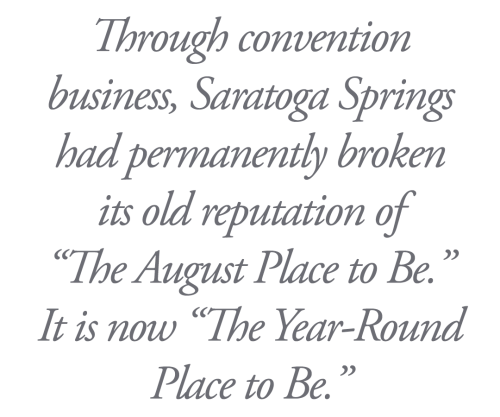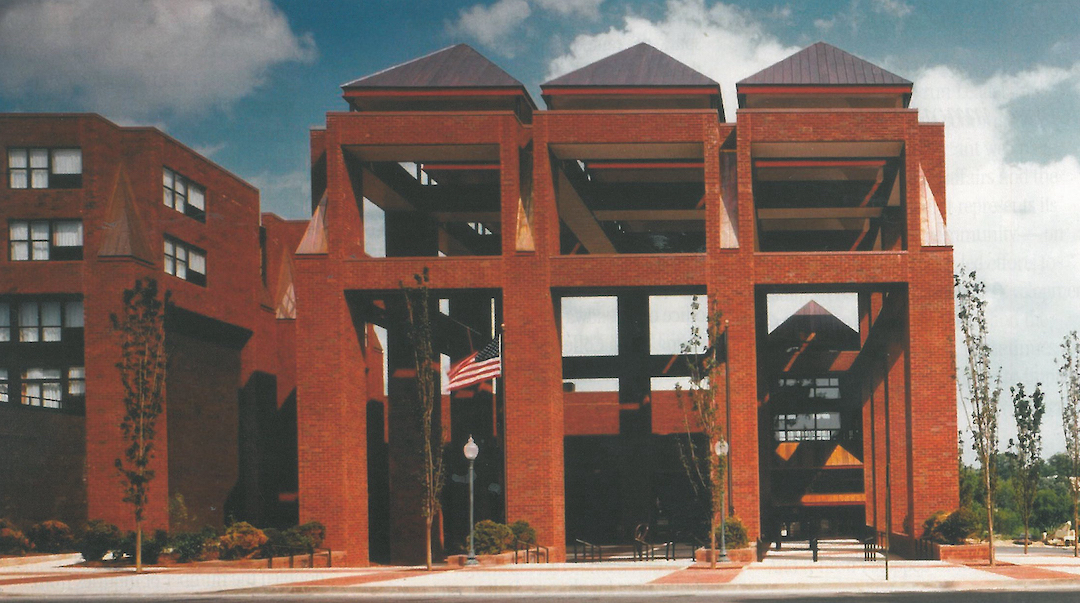Articles
The City Center
Photo courtesy of the Saratoga Springs City Center.

Many consider the opening of the City Center in the summer of 1984 to be one of the most important achievements in the rebirth of Saratoga Springs. Without it, Saratoga would not have the substantial convention business that has strengthened the city’s economy. Saratogians worked for more than 18 years to make the new facility a reality, ever since the city’s historic Convention Hall was destroyed by fire in 1965.
The convention business began in the 1830s. Political conventions, professional meetings of dentists and teachers, reformers, and religious conferences were among the large events that found Saratoga Springs a perfect meeting place. The American Bar Association and American Bankers Association were both founded in City Hall. All but a handful of these meetings were scheduled between May and September, as the vast majority of Saratoga’s 3,000 hotel rooms were unheated. The convention business expanded so rapidly during the 1870s that by 1883, civic leaders admitted that a larger facility was needed and citizens voted to build one. Groundbreaking took place in 1892, and Convention Hall opened in 1893.
The massive building with its twin towers rose on South Broadway where the Park Place condominiums now stand. The hall seated 5,000 in its auditorium and balcony and was key to attracting convention business, which began to boom. Its zenith was almost certainly in September 1907 when 40,000 Civil War veterans descended on Saratoga Springs for the “encampment” of the Grand Army of the Republic.
As the 20th century went on, the mix of events attracted to Convention Hall changed. The hall provided space for pro, semi-pro, industrial league, and high school basketball competitions – repeatedly hosting the Harlem Globetrotters – as well as wrestling matches and Skidmore College commencements. Enrico Caruso and John McCormack sang there; Paul Whiteman’s and Fred Waring’s orchestras, the Kingston Trio, and Peter, Paul and Mary performed there in concert. But the stock of hotel rooms declined dramatically when the grand old hotels came down between 1943 and 1953. It became difficult to house conventioneers; in 1960 only nine conventions came to Saratoga, bringing fewer than 3,000 conventioneers.
Another Convention Center to replace the one that burned was proposed at the present city arts council site. But before a final decision was made, catastrophic fire destroyed the old hall. The building was insured, and Commissioner of Public Safety John T. Roohan insisted that the $800,000 payout be deposited in a dedicated account. The Chamber of Commerce urged the City Council to take “immediate” action and a planner was soon hired, but no decisions were made, in part due to the insurance fund’s inadequate size. Years followed without decisive action by successive city councils. Fifteen years passed before newly elected Mayor Ellsworth Jones joined forces with the Chamber of Commerce to identify completion of a new City Center as top priority.
The plan was to increase sales tax by 1 percent for three to five years, raising $4 million, and the City Council adopted it in August 1981.
A group of the city’s civic leaders traveled to various convention centers sites in the eastern U.S. looking for design and financing ideas.

Planners estimated that the new facility would lose $150,000 to $200,000 a year, so it was clear it would require a subsidy. Under the chairmanship of Charles Wait of the Adirondack Trust Company, a planning committee began in December 1981 to assemble a creative and complex financing plan: the plan called for the city to build the new $4 million Convention Center, and sell it to an investment group. The city would then lease the facility from the investment group for fifteen years. At the conclusion of the fifteen year lease the city would purchase the center at a price agreed upon to at the initial sale. Due to the interest rate differentials, the city would then own the building it had maintained and still have over $3 million of the original $4 million in the bank. The operating deficit would be paid by a hotel built adjacent to the City Center through a “payment in lieu of taxes.” This assured that the anticipated City Center deficit would be covered by the privately owned hotel complex and not by the existing property tax base.
Meanwhile, planners recognized that the City Center would not be successful unless its operations were independent of political forces. In July 1982, a bill creating a seven-member Saratoga Springs City Center Authority, sponsored by State Senator Joseph Bruno, was enacted into law.
The new City Center could seat 2,500 in 37,000 square feet. After 19 long years, the city once again had a convention facility and, unlike the beloved Convention Hall, the new one was up-to-date.
Filling it was the next challenge. David Morris of the Saratoga Harness Track, Dan Murphy of the adjacent Ramada Renaissance Hotel, and Mary Reed of Saratoga Circuit Travel & Tours formed the Saratoga Convention and Tourism Bureau. The bureau, in cooperation with Mark Baker, president of the City Center, initiated action that began filling the center on a regular basis.
In 1999, the city bought back the facility. Ten years later, the timing was right for a major expansion. The City Center board, headed by Michael Toohey, led the planning process.
A funding package of $16 million was secured, including $12 million from the state by-Senator Majority Leader, Joe Bruno, plus Authority funds. Expansion would increase floor space by 50 percent.
Through an increase in the room occupancy tax the City Center cover its operating deficit, maintenance, and capital improvements.
Through convention business, Saratoga Springs had permanently broken its old reputation of “The August Place to Be.” It is now “The Year-Round Place to Be.”
